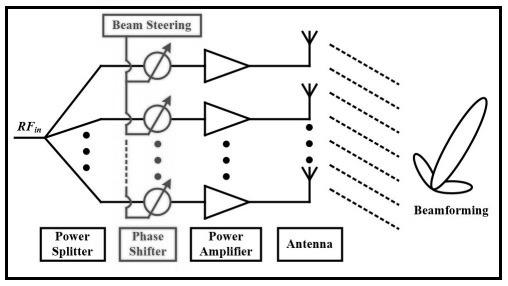Phased Array Antenna: An Overview of Applications and Advantages
Advertisement
A phased array antenna is an advanced antenna system employing an array of individual antennas. Its signals are electronically controlled to shape and steer the radio wave beam in desired directions without physical movement. This provides rapid beam direction changes and enhances the performance and flexibility of the antenna system for diverse applications.

The figure depicts a phased array antenna which employs RF phase shifters for its operation.
The key elements of phased array antennas include:
- Array elements
- Beam steering using phase shifters
- Beamforming using antennas
Key features include:
- Comprises multiple radiating elements (antennas), typically arranged in a grid or linear pattern. Each element can be controlled independently or in groups.
- Beam direction is controlled by adjusting the phase of the signal at each antenna element. Beam direction can be changed rapidly by altering the phase shifts electronically, allowing for real-time beam steering.
- By controlling the amplitude and phase of the signal at each element, the antenna can form a beam with a specific shape and direction. Beamforming improves signal strength and reduces interference.
Advantages of Phased Array Antennas
Following are the benefits or advantages of Phased Array Antennas:
- Rapid Beam Steering: No physical movement is needed to change the beam direction, enabling quick and precise adjustments.
- Improved Signal Quality: Beamforming enhances signal strength and reduces interference and noise.
- Multiple Beams: Can generate multiple beams simultaneously, allowing for communication with multiple targets or areas.
- Reliability: Lack of moving parts reduces mechanical wear and increases system reliability.
Phased Array Antenna Applications
Following are the applications of phased array antennas:
- Radar Systems: Used in air defense radar, missile tracking, and surveillance systems for detecting and tracking targets. It is also used in weather radar for meteorology, tracking weather patterns and detecting severe weather conditions.
- Telecommunications: Phased arrays are used in 5G base stations to provide high-speed wireless communication with beamforming capabilities. Moreover, it enables high-speed data transmission and reliable communication links between satellites and ground stations.
- Radio Telescopes: Used in radio astronomy for observing celestial objects and phenomena with high precision and sensitivity.
- Space Exploration: Employed in space probes and satellites for communication with ground control and data collection.
- Electronic Warfare:
- Jamming and Deception: Used to disrupt enemy radar and communication systems by directing jamming signals.
- Employed for intercepting and analyzing enemy communication signals.
- Navigation Systems: Phased array antennas are used in advanced GPS systems for improved accuracy and reliability. In aviation, it is employed for aircraft navigation and collision avoidance systems.
- Medical Imaging (MRI and Ultrasound): Used in medical imaging devices to enhance image resolution and to target specific areas.
- Automotive: Phased array antennas are used in vehicle-to-vehicle (V2V) and vehicle-to-infrastructure (V2I) communication systems for improved safety and navigation.
- Television and Radio Broadcasting: Employed in broadcasting systems for directional signal transmission and reception.
Conclusion
Phased array antennas represent a significant advancement in antenna technology. It offers flexibility, reliability, and high performance across a wide range of applications across industries.
Advertisement
 RF
RF



